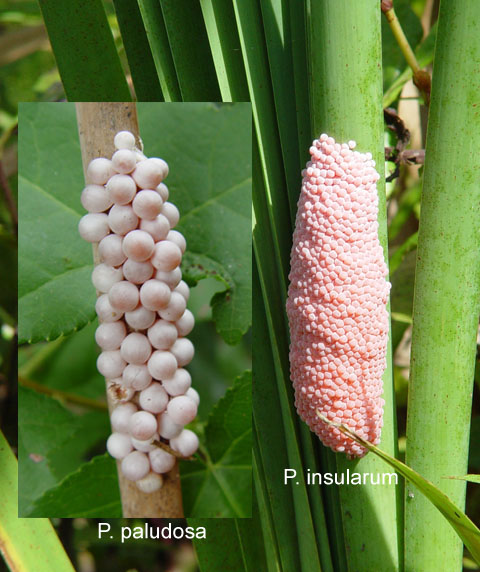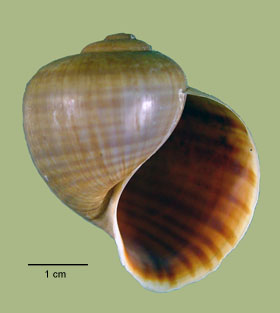> Habitat & Distribution
The natural range of P. paludosa is generally given as the Florida peninsula, extending as far north as springs in the lower Apalachicola/Flint and Ocmulgee/Altamaha River systems of Georgia (Clench & Turner 1956, Thompson 1999). The snail is an inhabitant of shallow lentic environments - lake margins, ponds, swamps, marshes and ditches where macrophytic vegetation is plentiful.
Our recent surveys have not confirmed the occurrence of P. paludosa in the Altamaha or in any other Georgia Atlantic drainage. The single South Carolina population of which we are aware, on Spring Island near Beaufort, seems to result from an artificial introduction. See my essay of 14Aug08 from the link below. Pomacea paludosa is pseudo-rare in US Atlantic drainages, FWGNA incidence rank I-1p.
> Ecology & Life History
As is typical of ampullariids in general, P. paludosa is primarily a consumer of aquatic macrophytes (Sharfstein & Steinman 2001, Morrison & Hay 2011). The snails are able to enfold a pocket of air in their mantle cavity, much like a pulmonate, by which they float on the surface of rich, calm waters, grazing on macrophytic vegetation of any sort tender enough for their jaws and radula to penetrate (Dillon 2000:97-99). It is not my impression that the biology of P. paludosa differs in any significant respect from that of the invasive P. canaliculata or P. maculata, which are much better-studied (eg., Estebenet 1995, Joshi & Sebastian 2006, Hayes et al. 2015, Joshi et al. 2017). But until P. paludosa is introduced into fields of rice or other aquatic crops, it will not be considered a pest, nor will funding follow for more complete studies.
The snail itself is famously the prey of the endangered Everglades kite (Snyder & Snyder 1969, Stevens et al. 2002), and certainly a variety of other large-bodied predators, less well documented (Snyder & Snyder 1971). There is some evidence of competition or inhibition of P. paludosa populations by introduced populations of P. maculata (Morrison & Hay 2011, Posch et al. 2013).
Sexes are separate. Research with the better-known P. canaliculata suggests that sex determination may be oligogenic (Yusa 2004b, 2006, see also my essay of 11Aug05 below). Egg masses are fastened on emergent vegetation above the water level, hatching with the rains into juveniles perhaps 3 - 5 mm in shell length. Maturity is reached at about 30-40 mm, a size which typically requires a year to achieve (Kushlan 1975). Adult snails can live for several years, reproducing iteroparously (life cycle G of Dillon 2000: 158).
The life history dsiplayed by Pomacea populations (in general) can be seen as an adaptation to the periodic filling and and dewatering of subtropical wetland environments (Darby et al. 2002). During dry periods the adults burrow and aestivate, while their egg masses are protected by calcareous shells on the reeds and cat-tails above.
> Taxonomy & Systematics
Systematic relationships within the Ampullariidae have been the object of much research in recent years (Cowie et al. 2006). At the species level, however, Pomacea paludosa has remained taxonomically stable.
> Maps and Supplementary Resources
- Map of Pomacea distribution in the Atlantic drainages (2023)
- Pomacea distribution in Georgia and the Florida panhandle (2025)
- Photomontage comparing egg masses of P. maculata ("insularum") and P. paludosa

> Essays
- See my post of 11Aug05, "Ampullariids star at Asilomar" for a review of Yoichi Yusa's oligogenic model of sex determination in Ampullariids on 11Aug05, together with some thoughts regarding the ongoing systematic work of Cowie and Hayes.
- I reported the discovery of a South Carolina population of P. paludosa in my "Two Dispatches from the Pomacea Front" on 14Aug08, and offered some comparisons with the South American invasive Pomacea maculata (ne insularum), recently introduced into ponds in the Myrtle Beach area.
> References
Albrecht, E. A., Carreno, N.B. & Castro-Vazquez, A. (1999) A quantitative study of environmental factors influencing the seasonal onset of reproductive behaviour in the south American apple-snail Pomacea canaliculata (Gastropoda: Ampullariidae). J. Molluscan Stud. 65: 241-250.
Andrews, E. B. (1964) The functional anatomy of the mantle cavity, kidney and blood system of some pilid gastropods. J. Zool. 146: 70 - 94.
Andrews, E. B. (1965) The functional anatomy and histology of the reproductive system of some pilid gastropod molluscs. Proc. Malac. Soc. Lond. 36: 121 -140.
Clench, W. J., & R. D. Turner (1956) Freshwater mollusks of Alabama, Georgia and Florida from the Escambia to the Suwannee River. Bull. Fla. State Museum, Biological Sciences 1: 97-239.
Cowie, R. H., K. A. Hayes, & S. C. Thiengo (2006) What are apple snails? Confused taxonomy and some preliminary resolution. pp 3 - 23 in R. C. Joshi & L. S. Sebastian (eds.), Global advances in ecology and management of golden apple snails. Philippine Rice Research Institute, Nueva Ecija.
Darby, P. C. et al. (1999) A comparison of sampling techniques or quantifying abundance of the Florida apple snail (Pomacea paludosa) J. Moll. Stud. 65: 195 - 208.
Darby, P. C. et al. (2002) Movements of Florida apple snails in relation to water levels and drying events. Wetlands 22: 489-498.
Dillon, R. T., Jr. (2000) The Ecology of Freshwater Molluscs. Cambridge University Press, 509 pp.
Estebenet, A. L. (1995) Food and feeding in Pomacea canaliculata (Gastropoda: Ampullariidae). Veliger 38: 277-283.
Estebenet, A. L. & N. Cazzaniga (1992) Growth and demography of Pomacea canaliculata under laboratory conditions. Malac. Rev. 25: 1-12.
Florida Fish and Wildlife Conservation Commission. "Non-native applesnails in Florida [PDF]."
Ghesquiere, S. "Pomacea paludosa" www.applesnail.net.
Hayes, K. A., and 32 other authors. 2015. Insights from an integrated view of the biology of apple snails (Caenogastropoda: Ampullariidae). Malacologia 58: 245-302. [FWGNA Review].
Joshi, R. C. & L. S. Sebastian (2006) Global advances in ecology and management of golden apple snails. Philippine Rice Research Institute, Nueva Ecija. 600 pp. [FWGNA Review]
Joshi, R. C., R. H. Cowie, & L. S. Sebastian (2017) Biology and management of invasive apple snails. Philippine Rice Research Institute. 406 pp. [FWGNA Review]
Kushlan, J. (1975) Population changes of the apple snail, Pomacea paludosa, in the southern Everglades. Nautilus 89: 21-23.
Morrison, W.E., and M.E. Hay. 2011. Feeding and growth of native, invasive and non-invasive alien apple snails (Ampullariidae) in the United States: Invasives eat more and grow more. Biological Invasions 13(4):945-955.
Posch, H., A.L. Garr, and E. Reynolds. 2013. The presence of an exotic snail, Pomacea maculata, inhibits growth of juvenile Florida apple snails, Pomacea paludosa. Journal of Molluscan Studies 79(4):383-385.
Sharfstein, B. & A. D. Steinman (2001) Growth and survival of the Florida apple snail (Pomacea paludosa) fed three naturally occurring macrophyte assemblages. JNABS 20: 84 -95.
Snyder, N. & H. Snyder (1969) A comparative study of mollusk predation by limpkins, Everglade kites, and boat-tailed grackles. Living Bird 8: 177-223.
Snyder, N. &. H. Snyder (1971) Defenses of the Florida apple snail Pomacea paludosa. Behaviour 40: 175-215.
Stevens, A. J., Z. C. Welch, P. C. Darby & H. F. Percival (2002) Temperature effects on Florida apple snail activity: implications for snail kite foraging success and distribution. Wildl. Soc. Bull. 30: 75-81.
Thompson, F. G. (1999) An Identification Manual for the Freshwater Snails of Florida. Walkerana 10 (23): 1 - 96. [Online Version]
Valentine-Darby, P.L., P.C. Darby, R.E. Bennetts, W.M. Kitchens & H.F. Percival (2008) The use of mark-recapture to estimate Florida apple snail (Pomacaea paludosa Say) density in wetland habitats. Florida Scientist 71: 115-127.
Yusa, Y. (2004a) Inheritance of color polymorphism and the pattern of sperm competition in the apple snail Pomacea canaliculata. J. Moll. Stud. 70: 43 - 48.
Yusa, Y. (2004b) Brood sex ratio in the apple snail Pomacea canaliculata is determined genetically and not by environmental factors. J. Moll. Stud. 70: 269 - 275.
Yusa, Y. (2006) Genetics of sex-ratio variation inferred from parent-offspring regressions and sib correlations in the apple snail Pomacea canaliculata. Heredity 96: 100-105.4.








